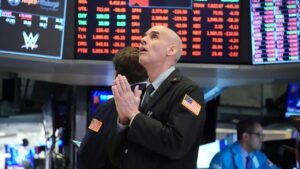By Chuck Mikolajczak
NEW YORK (Reuters) -U.S. stocks closed higher on Thursday, after the Federal Reserve announced a cut of 25 basis points (bps) in interest rates, extending a sharp rally sparked by Donald Trump’s return as U.S. president.
The Fed cut interest rates by a quarter of a percentage point as policymakers took note of a job market that has “generally eased” while inflation continues to move toward the U.S. central bank’s 2% target.
Markets had almost fully priced in a 25-basis-point rate cut for the November meeting and will now eye upcoming commentary from the central bank for guidance about the path of monetary policy.
Investor expectations that Trump would lower corporate taxes and loosen regulations sparked a surge in each of the three major indexes in the prior session, with both the Dow Industrials and recording their largest one-day percentage jumps in two years.
“In an action-packed week, the Fed didn’t add any drama. Cutting by 25 basis points still keeps the federal funds rate restrictive, but not as restrictive as it was,” said Brian Jacobsen, chief economist at Annex Wealth Management in Menomonee Falls, Wisconsin.
“Elections have consequences and we could see a marginal improvement in growth relative to their forecasts, but also a marginal increase in inflation relative to their forecasts. That would call for a more gradual pace of rate reductions.”
The fell 0.59 point, or flat, to 43,729.34, the S&P 500 gained 44.06 points, or 0.74%, to 5,973.10 and the gained 285.99 points, or 1.51%, to 19,269.46.
Communications services, up 1.92%, led S&P sector gains, buoyed by a jump of 11.81% in Warner Bros Discovery (NASDAQ:) after a surprise third-quarter profit.
were the weakest of the 11 major S&P sectors, down 1.62% to give back some of the outsized gains in the prior session, as banks declined 3.09% after a surge of nearly 11% on Wednesday. JP Morgan lost 4.32% and Goldman Sachs shares shed 2.32% to weigh on the Dow.
Expectations for continued rate cuts have been dialed back recently, however, as economic data continues to point to a resilient economy and the potential for higher inflation as a result of likely tariffs and increased government spending under Trump’s administration.
Fed Chair Jerome Powell said no decision has been made on what sort of policy action the central bank will take in December but the central bank is “prepared to adjust our assessment of the appropriate pace and destination” for monetary policy amid uncertainty.
Investors are also eying whether Republicans could win control of both houses of Congress, making it easier for Trump’s agenda to proceed.
Treasury yields, which have surged in recent weeks, retreated after a sharp rise on Wednesday, as the benchmark 10-year yield eased from a four-month high of 4.479%, before briefly paring declines slightly after the Fed statement and were last at 4.332%.
Data earlier on Thursday showed U.S. weekly jobless claims rose marginally last week, suggesting no material change in labor market conditions.
Advancing issues outnumbered decliners by a 1.94-to-1 ratio on the NYSE and by a 1.18-to-1 ratio on the Nasdaq.
The S&P 500 posted 56 new 52-week highs and 4 new lows while the Nasdaq Composite recorded 193 new highs and 88 new lows.
Volume on U.S. exchanges was 16.78 billion shares, compared with the 12.46 billion average for the full session over the last 20 trading days.
Read the full article here

















